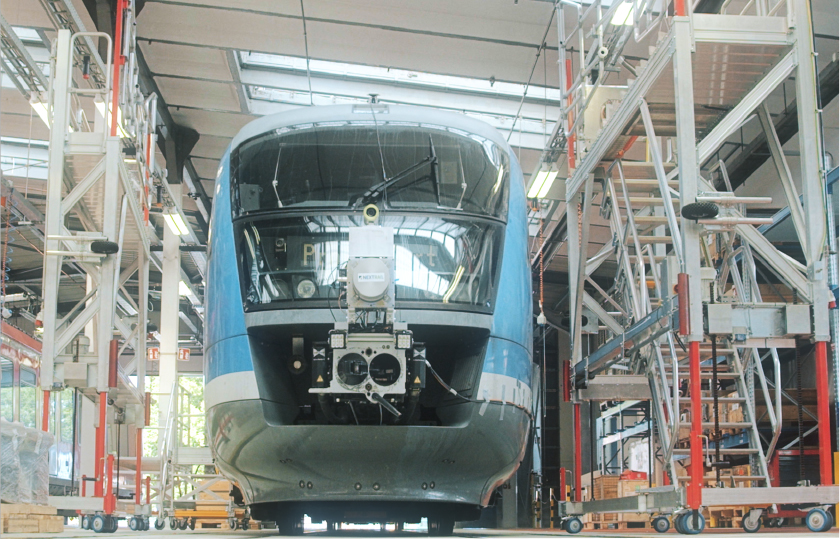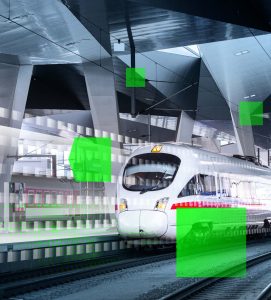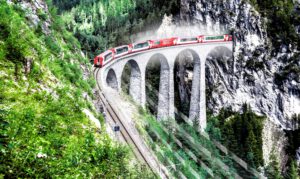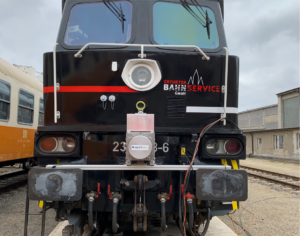System know-how for high efficiency roll-outs
Comprehensive system knowledge of the railway technologies of today and tomorrow
Digitisation marks the beginning of a new era that shows that the railways have pioneering answers to the mobility questions of the future. To get this potential on track and on-board the rolling stocks, an integral approach is needed. A holistic approach that captures how existing and new architectures and all their components are intelligently interlinked.
NEXTRAIL supports you in the transformation of your railway architecture in an interdisciplinary manner across all technological fields. With the utmost expertise. Throughout the entire life cycle. With experienced teams of experts who know how digitisation can unleash its full potential in practice.
TMS – Traffic Management System is one of the key technologies for sustainably increasing the capacity and performance of the entire railway infrastructure.
No later than the definition of the European Rail Traffic Management System (ERTMS), the TMS was also identified as a central component of all rail infrastructure measures. The aim is to significantly increase rail capacity and train frequency on the railways and to make the networking and information processes between the control-command and signalling technology and the rolling stocks more efficient. This will make rail transport more economical and attractive – all without building additional tracks.
As a component – together with ATO, new interlocking technology and ETCS and on-board ETCS in the rolling stocks, a TMS enables more capacity on existing infrastructure and thus expands the ability to respond flexibly to the growing demand in passenger and freight transport.
To leverage the full potential of technological possibilities, the expert TMS teams at NEXTRAIL work closely with our departments for ATO, ETCS, digital interlockings, rolling stock, security and safety on an interdisciplinary basis.
NEXTRAIL actively participates in relevant, pioneering projects in the field of TMS and is therefore one of the leading knowledge carriers in this technology segment.
- The advantages of a TMS at a glance:
- Support and (partial) automation of conflict detection and resolution through real-time disposition
- Network-wide optimisation of train traffic based on defined rules and optimisation parameters
- Integration of control and command in one system, operated by one person, eases ATO operation
- Centralised information processes
- Flexible networking of functionalities to increase efficiency
- Efficient, user-centric user interface
Contact person for TMS

Dr Albrecht Achilles
Head of ATO/ TMS
ATO – the key technology for optimising energy efficiency and maximising line capacity
Automatic train operation (ATO) extends the possibilities for increasing the capacity on the track. In conjunction with ETCS and central planning systems (TMS), highly automated driving operations in open networks will be implemented in future. ATO is constantly being further developed and ultimately forms the basis for fully automated driving operations. ATO contributes to sustainably improving energy efficiency and maximising line capacity without additional tracks.
Thanks to their extensive expertise in all project phases from digital lighthouse projects such as the Digital S-Bahn Hamburg and Digital node Stuttgart, the ATO expert teams at NEXTRAIL have superb expertise in implementing automated driving operations with ATO over ETCS GoA 2 in regular operation.
NEXTRAIL is actively involved in the relevant pioneering projects in the area of ATO over ETCS GoA 2 and driverless driving. And, it is one of the leading knowledge carriers in this technology segment.
- Your advantages with ATO at a glance:
- Accurate adherence to speed specifications
- Capacity increase on existing infrastructure
- Reduction of energy requirements and wear
- More punctual, more stable operation
- Enables new, more flexible operating concepts
Contact person for ATO

ETCS – conceived essentially to simplify international rail traffic, digital train control systems are evolving into autopilot systems for greater safety and efficiency on the railways.
European Train Control System (ETCS) is a standardised train control system and a fundamental part of the ERTMS. With the introduction of ETCS Level 2 and wireless signal transmission (GSM-R) to the vehicles, ETCS is increasingly becoming a type of autopilot for rail.
ETCS monitors the train on the basis of precise positioning and predefined command parameters, enabling it to make exact decisions to keep the train safe, even at higher speeds. ETCS enables the transmission of information directly to the vehicle equipment. Driver’s cab signalling display/monitor eliminates the need for track-side signals and enables long-term savings in the installation and maintenance of railway operations.
The NEXTRAIL expert teams for the Stuttgart S-Bahn project have demonstrated the potential for increasing capacity on regional routes offered by ETCS Level 2 routes in conjunction with ATO and digital interlocking. The aim of the ETCS pilot project is to increase transport services by up to one million train kilometres per year. The holistic approach of the study included the following areas: engineering, certification, operations, planning, radio transmission, cost estimation and equipment strategy. The consideration was brought together in a cost estimate based on different equipment strategies.
NEXTRAIL is actively involved in relevant pioneering projects in the field of Advanced Protection System (APS) and ATO GoA 2 over ETCS and is one of the leading knowledge carriers in this technology segment.
- Your advantages with ETCS at a glance:
- Increase capacity and safety
- Highly available train control system
- Elimination of track-side signals
- Increased efficiency through networking with broad functionalities
- Sustainable savings in installation and maintenance
- Strengthens international freight and passenger transport
Contact person for ETCS

Jörg Liesche
Principal Consultant
Digital interlocking – an essential component in reducing costs and increasing the competitiveness of railways.
Digital interlockings are the successors of electronic interlockings and replace various types and generations of existing interlocking systems with digital control and safety technology. In contrast to electronic interlockings, a digital interlocking transmits the control commands of the disposition digitally in real time over almost any distance via fibre optic cable to points and signals.
By standardising the interfaces, complete systems with components and technical solutions from various manufacturers can be implemented, continuously modified or expanded. Digital interlockings thus make a significant contribution to reducing time and costs. Whether installing, commissioning or maintaining railway infrastructure.
The expert teams for digital interlockings at NEXTRAIL have extensive experience from the industry and railway operation side and have excellent knowledge of the advantages and disadvantages of digital interlocking modules and components offered on the market and the adjacent systems. We define the best overall solution from a technical, functional and economic point of view on the basis of your requirements.
Within the framework of EULYNX, NEXTRAIL is working on the definition of future standards for the standardisation of signal components and signal interfaces.
- Your advantages of digital interlockings at a glance:
- Sustainable reduction of time and costs
- Free choice of components thanks to standardised interfaces
- Intelligent, condition-based maintenance
- Consistent separation of energy and data
Contact person for digital interlocking

Marco Gerlach
Head of Railway Engineering
Digital map and digital twin – precise digital infrastructure data as a core component in planning, construction and operation For greater efficiency and safety in the route network.
Topography and infrastructure in a digital mirror image – as a digital map or a digital twin. The digital map contains data on tracks as well as their environment and elements that are used directly for planning, project design, validation and configuration of railway systems. The digital twin for infrastructure data is an exact, digital spatial representation of reality and plays a decisive role, for example, in predictive and intelligent maintenance or operational simulation of current or future capacities Up-to-date and reliable digital infrastructure data is an essential core component in order to be able to safely operate high-frequency trains at optimum intervals on digitised routes. This is both during the planning phase and later on for the entire life cycle of the railway system.
In railway systems such as interlockings or TMS, this static infrastructure data from the digital map is linked to dynamic information such as train location, train speed, train completeness and much more. For a reliable representation of the route network and moving objects in real time. As a reliable source of information for the intelligent control of traffic flows. In the future, the digital map will form the basis of all decisions as a single source of truth.
The digital map and digital twin expert teams at NEXTRAIL have extensive process knowledge in defining, capturing, evaluating, locating, validating, transforming, visualising and distributing reliable infrastructure data. With many years of expertise from national and international lighthouse projects.
To make your data management even smarter, NEXTRAIL has developed an intelligent and reliable process with its TRAXIMIZER, TRAXPLORER and TRAXHUB product lines. For capturing, processing and providing secure infrastructure data for a digital and intelligent railway system of tomorrow.

- The advantages of digital maps and digital twins at a glance:
- Core component for safe and high-performance operation of the digital rail system
- Development of individual or standardised processes for efficient and reliable data generation and distribution
- Minimises cost and project risks as early as the planning stage
- Full security and availability of all infrastructure data
- Creation of the data basis for BIM, digital maps, digital twins or single source of truth
Contact person for digital maps and digital twins

Dr Benedikt Wenzel
Head of Railway Data
Rolling stock – the digitalization of railway systems demands vehicles equipped with advanced on-board intelligence.
ETCS (European Train Control System) has already become the European standard, and the gradual shift towards autonomous trains and more efficient command and control systems is inevitable. As a result, more functions are being transferred from trackside systems to the rolling stock itself.
ETCS demands safe positioning and a limited integration with the vehicle. In contrast, ATO (Automatic Train Operation) requires precise location data and the ability to accurately trigger traction and braking commands. Additionally, an intelligent Train Management System (TMS) relies on the on-board system to collect all relevant vehicle status information in real-time and to apply updated driving profiles instantly. With ATO at Grade of Automation 4 (GoA 4), the on-board unit and sensors must autonomously analyze the environment and detect potential hazards immediately. Thus, the digital capabilities of rolling stock are becoming the key enablers for the future of railway technology.
Modern rolling stock must be able to interface with wayside ETCS equipment using appropriate communication solutions, such as GSM-R or GPRS. Ideally, they should also be prepared for future developments in the rail system. However, in some cases, basic ETCS compatibility may suffice. That’s why NEXTRAIL’s rolling stock experts prepare and support projects with both medium- and long-term goals in mind, while also considering the specific needs of each fleet, particularly for retrofit projects.
NEXTRAIL offers system expertise across all areas, from signaling to rolling stock and vehicle retrofitting, ensuring perfectly coordinated solutions and smart project management.
The advantages of rolling stock service at a glance:
- Integration of fleet upgrade challenges in feasibility studies of network or node ETCS/ATO upgrades
Definition of the optimum technical on-board solution versus ETCS/ATO route compatibility and public funding laws.
Optimization of the integration level with the rolling stock fleet with regard to vehicle operation and maintenance
Definition of rolling stock parameters for ETCS and ATO (e.g. braking curves)
System thinking and rolling stock experience for the design of GoA 2 to GoA 4 solutions, with short-term return on investment
Optimisation of the project process through cross-divisional ETCS and ATO expertise, e.g. in the optimisation of ESC tests
Contact person for rolling stock

Vincent Blateau
Head of Rolling Stock Domain
Services
Complete process know-how. Intelligence from a single source.
Effective knowledge transfer, streamlined processes and quick access to in-depth technical expertise. Thanks to agile structures and experienced railway experts from a wide range of disciplines, NEXTRAIL is able to seamlessly cover all phases of the product life cycle of railway signalling systems.
Our Partners













